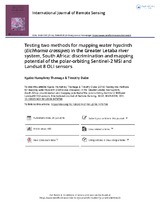| dc.contributor.author | Thamaga, Kgabo Humphrey | |
| dc.contributor.author | Dube, Timothy | |
| dc.date.accessioned | 2021-07-14T07:21:58Z | |
| dc.date.available | 2021-07-14T07:21:58Z | |
| dc.date.issued | 2018 | |
| dc.identifier.citation | Thamaga, K. H., & Dube, T. (2018). Testing two methods for mapping water hyacinth (Eichhornia crassipes) in the Greater Letaba river system, South Africa: Discrimination and mapping potential of the polar-orbiting Sentinel-2 MSI and Landsat 8 OLI sensors. International Journal of Remote Sensing, 39(22), 8041–8059. https://doi.org/10.1080/01431161.2018.1479796 | en_US |
| dc.identifier.issn | 1366-5901 | |
| dc.identifier.uri | https://doi.org/10.1080/01431161.2018.1479796 | |
| dc.identifier.uri | http://hdl.handle.net/10566/6400 | |
| dc.description.abstract | Early detection and mapping of the spatio-temporal distribution of
invasive water hyacinth (Eichhornia crassipes) in inland hydrological systems are vital for a number of water resource managementrelated reasons. Field surveys and current climate change projections (associated with longer dry spells, and shortened rain seasons) have shown that climate change and the rapid spread of
aquatic invasive species are increasingly affecting inland surface
water availability in semi-arid regions of Southern Africa. It is upon
this premise that accurate, reliable, and timely information on the
spatio-temporal distribution and configuration of water hyacinth is
required in tracing their evolution and propagation in affected
areas as well as in potential vulnerable areas. This work, therefore,
attempts to test two robust push-broom multispectral sensors:
Landsat 8 Operational Land Imager (OLI) and Sentinel-2
MultiSpectral Instrument (MSI) in identifying, detecting, and mapping the spatial distribution and configuration of invasive water
hyacinth in a river system. The results of the study show that water
hyacinth in small reservoirs can be mapped with an overall accuracy of 68.44% and 77.56% using Landsat 8 and Sentinel-2 data,
respectively. | en_US |
| dc.language.iso | en | en_US |
| dc.publisher | Taylor & Francis | en_US |
| dc.subject | Greater Letaba river | en_US |
| dc.subject | Discrimination | en_US |
| dc.subject | Mapping | en_US |
| dc.subject | Water hyacinth (Eichhornia crassipes) | en_US |
| dc.subject | Climate change | en_US |
| dc.title | Testing two methods for mapping water hyacinth (Eichhornia crassipes) in the Greater Letaba river system, South Africa: Discrimination and mapping potential of the polar-orbiting Sentinel-2 MSI and Landsat 8 OLI sensors | en_US |
| dc.type | Article | en_US |

